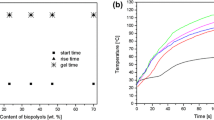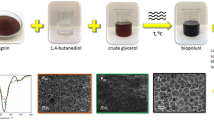Abstract
Hardwood residue (HR), a byproduct of paper industry, was liquefied by using polyethylene glycol 400 (PEG400) and ethylene carbonate (EC) as the liquefaction solvents, and concentrated sulfuric acid as the catalyst to produce bio-polyols (HRLP), which were used to synthesize polyurethane (PU) foams. The effects of conditions on the properties of HRLP and modified PU foams were investigated and the mechanism of biomass liquefaction was discussed. The optimum conditions of liquefaction were obtained as follows: reaction temperature of 160 °C, reaction time of 60 min, ratio of PEG400/EC of 8:2 (w/w), and ratio of liquid/solid of 5:1 (w/w). The characterization of HRLP modified PU foams suggested that HRLP could partially replace the petroleum polyols to synthesize PU foams. With the increase of the replacement percentage of HRLP, the apparent density and compressive strength of the foams increased firstly, and then decreased. Meanwhile, the thermal stability was improved slightly.
Similar content being viewed by others
References
Shafiee S, Topal E. When Will Fossil Fuel Reserves be Diminished[J]? Energy Policy, 2009, 37(1): 181–189
Stefanidis SD, Kalogiannis KG, Iliopoulou EF, et al. A Study of Lignocellulosic Biomass Pyrolysis via the Pyrolysis of Cellulose, Hemicellulose and Lignin[J]. J. Anal. Appl. Pyrolysis, 2014, 105: 143–150
Saidur R, Abdelaziz E, Demirbas A, et al. A Review on Biomass as a Fuel for Boilers[J]. Renew. Sust. Energ. Rev., 2011, 15(5): 2262–2289
Behrendt F, Neubauer Y, Oevermann M, et al. Direct Liquefaction of Biomass[J]. Chem. Eng. Technol., 2008, 31(5): 667–677
Liu Z, Zhang FS. Effects of Various Solvents on the Liquefaction of Biomass to Produce Fuels and Chemical Feedstocks[J]. Energy Convers. Manage., 2008, 49(12): 3498–3504
Chen F, Lu Z. Liquefaction of Wheat Straw and Preparation of Rigid Polyurethane Foam from the Liquefaction Products[J]. J. Appl. Polym. Sci., 2009, 111(1): 508–516
Kurimoto Y, Takeda M, Koizumi A, et al. Mechanical Properties of Polyurethane Films Prepared from Liquefied Wood with Polymeric MDI[J]. Bioresour. Technol., 2000, 74(2): 151–157
Hu S, Li Y. Two-step Sequential Liquefaction of Lignocellulosic Biomass by Crude Glycerol for the Production of Polyols and Polyurethane Foams[J]. Bioresour. Technol., 2014, 161: 410–415
Zia KM, Bhatti HN, Bhatti IA. Methods for Polyurethane and Polyurethane Composites, Recycling and Recovery: A Review[J]. React. Funct. Polym., 2007, 67(8): 675–692
Lligadas G, Ronda JC, Galià M, et al. Oleic and Undecylenic Acids as Renewable Feedstocks in the Synthesis of Polyols and Polyurethanes[J]. Polymer, 2010, 2(4): 440–453
Rezzoug SA, Capart R. Liquefaction of Wood in Two Successive Steps: Solvolysis in Ethylene-glycol and Catalytic Hydrotreatment[J]. Appl.Energ., 2002, 72(3): 631–644
Jin Y, Ruan X, Cheng X, et al. Liquefaction of Lignin by Polyethyleneglycol and Glycerol[J]. Bioresour. Technol., 2011, 102(3): 3581–3583
Zhang H, Pang H, Shi J, et al. Investigation of Liquefied Wood Residues based on Cellulose, Hemicellulose, and Lignin[J]. J. Appl. Polym. Sci., 2012, 123(2): 850–856
Zhang Q, Zhao G, Jie S. Effects of Phosphoric Acid on Liquefaction of Wood in Phenol and Optimum Liquefaction Processing Parameters[J]. Forestry Studies in China, 2004, 6(3): 50–54
Kurimoto Y, Tamura Y. Species Effects on Wood-liquefaction in Polyhydric Alcohols[J]. Holzforschung, 1999, 53(6): 617–622
Yamada T, Ono H. Rapid Liquefaction of Lignocellulosic Waste by Using Ethylene Carbonate[J]. Bioresour. Technol., 1999, 70(1): 61–67
Xie T, Chen F. Fast Liquefaction of Bagasse in Ethylene Carbonate and Preparation of Epoxy Resin from the Liquefied Product[J]. J. Appl. Polym. Sci., 2005, 98(5): 1961–1968
Lee WJ, Lin MS. Preparation and Application of Polyurethane Adhesives Made from Polyhydric Alcohol Liquefied Taiwan Acacia and China Fir[J]. J. Appl. Polym. Sci., 2008, 109(1): 23–31
Hu S, Luo X, Li Y. Polyols and Polyurethanes from the Liquefaction of Lignocellulosic Biomass[J]. Chem. Sus. Chem., 2014, 7(1): 66–72
Lin L, Yoshioka M, Yao Y, et al. Liquefaction Mechanism of Lignin in the Presence of Phenol at Elevated Temperature without Catalysts. Studies on β-O-4 Lignin Model Compound. III. Multi-Condensation [J]. Holzforschung, 1997, 51(51): 333–337
Pan H, Shupe TF, Hse CY. Synthesis and Cure Kinetics of Liquefied Wood/Phenol/Formaldehyde Resins[J]. J. Appl. Polym. Sci., 2008, 108(3): 1837–1844
Yamada T, Aratani M, Kubo S, et al. Chemical Analysis of the Product in Acid-catalyzed Solvolysis of Cellulose Using Polyethylene Glycol and Ethylene Carbonate[J]. J.Wood Sci., 2007, 53(6): 487–493
Yamada T, Ono H. Characterization of the Products Resulting from Ethylene Glycol Liquefaction of Cellulose[J]. J.Wood Sci., 2001, 47(6): 458–464
Lee SH, Teramoto Y, Shiraishi N. Biodegradable Polyurethane Foam from Liquefied Waste Paper and Its Thermal Stability, Biodegradability, and Genotoxicity[J]. J. Appl. Polym. Sci., 2002, 83(7): 1482–1489
Author information
Authors and Affiliations
Corresponding authors
Additional information
Funded by the National Natural Science Foundation of China (Nos. 51503041 and 51472050)
Rights and permissions
About this article
Cite this article
Lu, X., Wang, Y., Zhang, Y. et al. Preparation of bio-polyols by liquefaction of hardwood residue and their application in the modification of polyurethane foams. J. Wuhan Univ. Technol.-Mat. Sci. Edit. 31, 918–924 (2016). https://doi.org/10.1007/s11595-016-1468-7
Received:
Accepted:
Published:
Issue Date:
DOI: https://doi.org/10.1007/s11595-016-1468-7




